Kayaking With Kids – An Ultimate Guide & 10 Top Tips
Are you thinking of going kayaking with your kids?
Carl and I have always loved being on the water, whether that’s sailing, swimming or paddling. There’s something totally freeing about it. And after we had our kids we couldn’t wait to introduce them to kayaking as a safe and easy way to get them involved in water sports. Both of our boys have been paddling on the water since before they were a year old, proof that you can go kayaking with kids.
We know that it can be daunting trying it for the first time, so we wanted to share some of the things that we’ve learned along the way. Some top tips that will help you and your family kayak on the water and have lots of fun!
How old should kids be when you start kayaking with them?
We should start by saying that there is no best age for younger kids to take their first kayaking trip. While newborn babies shouldn’t go kayaking, you’ll be pleased to know that young kids can go paddling on the water with you. A young child and adult can happily share a kayak if the child can:
- Wear a well-fitting life jacket
- Sit comfortably and still in the kayak
- Float by themselves on the water
It really depends on the child, a bit like teaching them to ski or snorkel. However, realistically speaking, a great time to start young kids is around 2-5 years old. But, it ultimately depends on their maturity level, swimming skills, as well as their physical ability. Plus your own kayaking skills, experience and confidence. Our eldest son has been kayaking and standup paddle boarding with us since he was around a year old. And our youngest went out for the first time when he was 9 months old. We’ve taken them so soon as we live in Hamble on the Hamble River in Hampshire which has very calm water. As it’s close by we can just head out for a short 5-minute paddle.
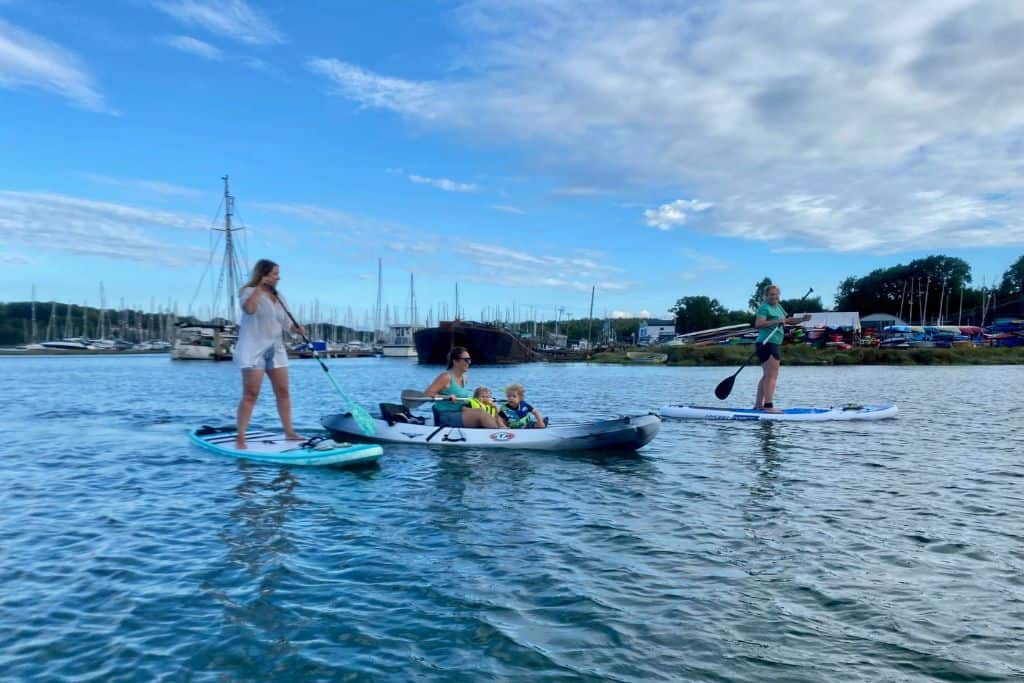
Where to seat young kids when you’re kayaking with them
Most younger children (under 7 years old) will start off as a duffer in your kayak. This means they’ll sit in the middle compartment. If you’re in a double kayak, then kids that can sit still and don’t need to be right by you can sit in the front seat (bow). That way they practice their own paddling skills using their kid-sized paddle. This is a fun and safe way to be near them to help build their confidence, paddling skills and stamina, before they go into a kayak of their own.
When should a child move into their own child sized kayak
Again, this “depends on the kid” because if you’ve been kayaking with them from an early age and they are confident at swimming and paddling. Then they could try going by themselves in a kids-sized kayak from 5 years old. They should start in calmer water with shorter bursts of kayaking on their own.
Make sure you stay near them in case they ask for your help or start to panic. If you have a tow line then take it in case they help when you’re out kayaking together you can help pull them along. When they are older and used to being on the water on their own they will start to be able to paddle longer distances without needing to take a break.
Kayaking Safely With Kids
Gear for kayaking as a family
Before you head out onto the water for the first time, you’ll want to be sure that you’ve the correct safety gear. Some items that we suggest that you carry or wear with you when you’re kayaking with kids are listed below.
Personal Flotation Device (PFD) or Life Jacket
Everyone should have a well-fitting and comfortable personal flotation device (PDF). You’ll want to check the sizing which is usually calculated on weight as well as making sure that it’s comfortable, especially for childrens life jackets. We buy ours from Baltic as they’re really comfortable and we also use them when we take the kids sailing. If you’re renting a kayak then they should provide you with a life jacket as part of the rental.
Throw Bag
A throw bag is a good idea and a great safety equipment to have with you. These bags are buoyant and can be thrown towards a paddler of any age when they capsize. They then take hold of the line/rope within the bag as you pull them towards you. They’re great for if/when your child falls from the kayak and panics.
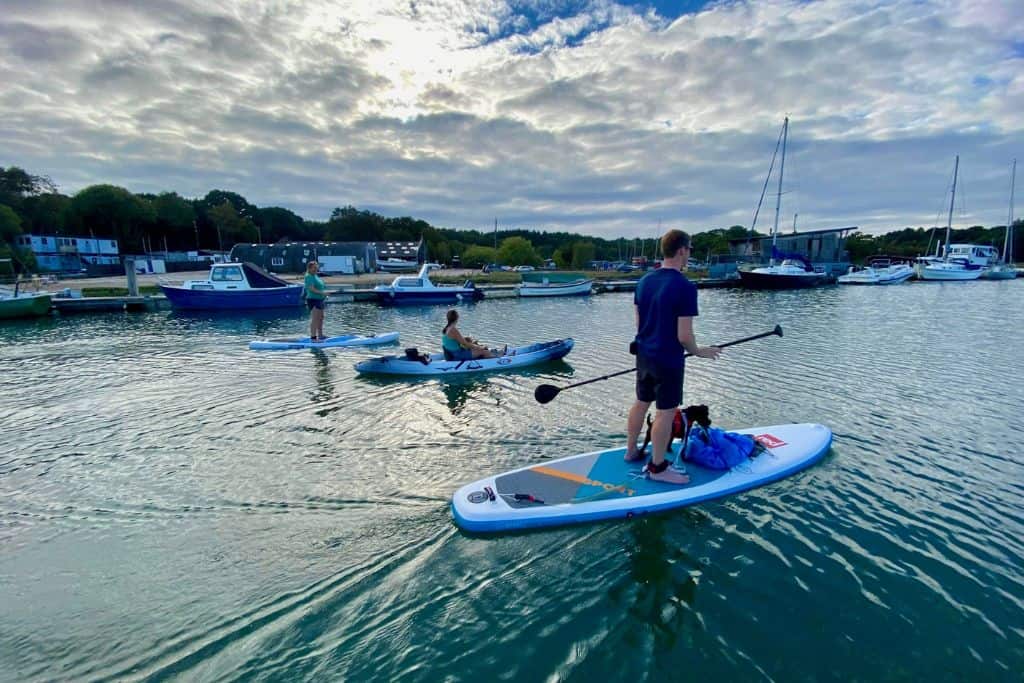
Kayak Tow Line
If you’re kayaking with two or more kayaks, for example when your child starts paddling on their own, having a tow line is a great idea. The tow line can be easily attached to your kid’s kayak which means you can help when they’re tired and by helping them to feel safe as they’re learning to kayak on their own. There are two ways to use the tow line, firstly you can clip it below your life jacket around your waist. Or, alternatively as a line that attaches both kayaks together.
First Aid Kit For Kayaking
We always carry a first-aid kid for any outdoor adventures that we have. Just remember to put it into a dry bag so that the contents are protected from getting wet.
Repair Kit
If you’ve got an inflatable kayak like we do, then it’s likely that it was sold with its own repair kit. It’s worth having it on you when you kayak, and also having checked how it works in advance. Because when you do rupture or puncture your kayak you’ll want to use it easily and quickly. If you’re running low then you should buy extra glue and patches to have backup stocks for use in an emergency.
Precautions when kayaking with kids
You should talk about all of the parts of your kayak, for example where safety gear can be found, and what they should do in case of the kayak capsizing. This is very important when you are with older kids and using a sit-in kayak. We always practice any things new with our kids on the land before we go out onto the water. That we know that they know what’s happening.
Go over your rules
We go over your safety rules multiple times like we do when we go sailing. The rules should be clear and simple so that they can’t be confused. A great example is, no standing, messing around or leaning out. We also discuss why we shouldn’t do them and why they aren’t safe.
Head out with an experienced paddler
We’re both competent paddlers, however, if you aren’t then you should make sure that you head out with an experienced paddler the first time that you go kayaking with your kids. This is especially the case for locations with rougher waters or for longer trips. Also, younger kids should always kayak with an adult in with them until they’re confident and experienced enough to happily kayak on their own.
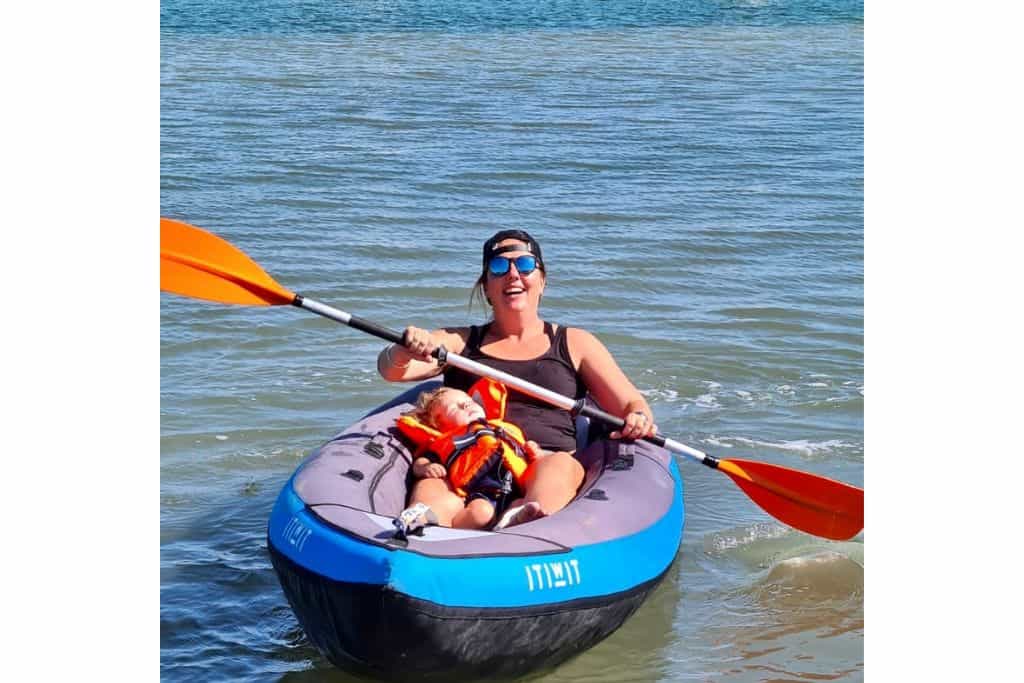
Check the weather and tides before you go
We’d suggest that you always check on the tides, weather forecast and currents before you head out. Even on calm waters like our local river, if the tide and wind aren’t right then we can get pushed down stream and have a battle of a paddle on our hands. It’s always a good idea to prepare a backup plan because if the weather is really bad you might want to cancel your paddle. If the weather drastically changes when you’re on the water, then you should head towards the shore straight away for safety.
Where to Go Kayaking With Kids
When starting on your paddling adventures, you should look for places with calmer water with less current. It will allow small children to get comfortable with kayaking and a chance to practice their paddling skills in a safe (and stree-free) environment. Small lakes, slow rivers, and quiet bays are a great place to begin kayaking.
If you can then choose a place with lots to see, this will save you getting complaints of “I’m bored” from smaller kids. This will help reduce the wiggling from younger children when they’re sharing a kayak with you. Fun features to look out for such as bridges and tunnels, along with varying landscapes with lots wildlife always help us to keep it interesting when paddling with our boys. We love a game of “spot the bird” to keep us entertained!
You should steer clear (yes, pun intended) of places that have motorboat traffic, because dodging can be very dangerous. Especially as it can become stressful for you on what should be a fun adventure.
Best Length Trip For Kayaking With Kids
This depends on several factors such as their experience, age and attention span, because heading on a three hour paddle might not be right for very young kids like ours. We’d suggest starting with shorter trips (such as 30 minutes out on the water). Then, as they get more used to kayaking, you can slowly increase the time with every trip. Our first few times on the water were literally 10 minutes long as we got the boys familiar with the feeling of being in the kayak on the water. We slowly built up the time from there. A bit like when we took our kids camping for the first time and just went for a night to start with.
A good way to make their kayaking adventure longer is to have regular breaks along your trip. You can get them out onto the shore to run about and give their legs a good stretch. We our boys we like to include some swimming before they get back into our kayak. Another idea is heading to the shore or beach for a small picnic, or toilet break or maybe just having some time to explore around area. We love to plan a kayak trip that involves a picnic or pub stop along the way – we have a fair few on the Hamble River to enjoy!
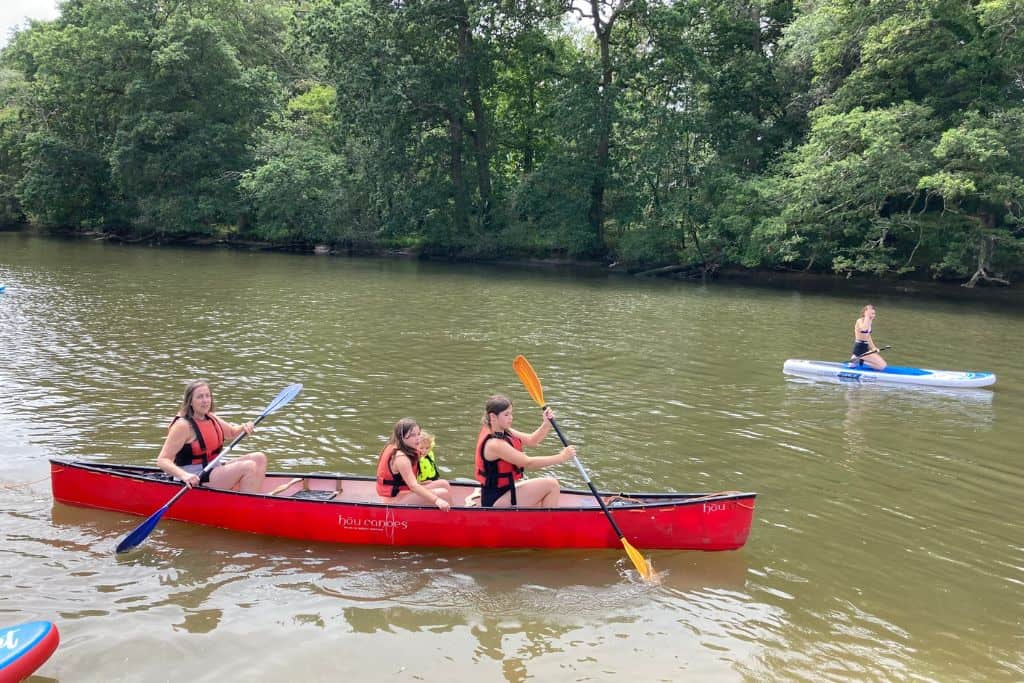
10 Best tips for kayaking with kids
1. Start short and slow
With anything that we do with our kids, we like to start slowly, that way we don’t put them off and have a chance to bail if things aren’t going to plan. We’ve realised that you can then build up speed and distance with each trip. The first trips should really be focussed on your child getting used to the feel of the kayak and paddles.
2. Practice and games
Anything that we teach our kids takes time and plenty of practice, especially as they’re younger children. We never expect them to learn something the first time and we know that also playing games helps them to remember things. Even something as simple as I Spy is a great way to keep them engaged as you kayak along. We also love looking for pirates and crocodiles – funnily enough we’ve not found any yet! For older children who are paddling themselves, you can set up kayak races or a game of tag.
3. Take lots of breaks
We’ve found that we always need to plan lots of breaks for new activities because they can be overwhelming and this can tire kids out quicker than expected. There are lots of options, whether you are getting out to stretch your legs, have a picnic, or simply take a paddle break on the water to enjoy the scenery. The main thing is to find the time to rest and break up the paddling.
4. Make it a fun and positive experience
Your kids will make mistakes learning to kayak, and you should feel comfortable letting them make mistakes (safe ones). Because learning from their mistakes can help them learn good paddling techniques. We always praise good effort and paddling all along the way, Cam loves to hear how proud we are when he gives paddling a go!
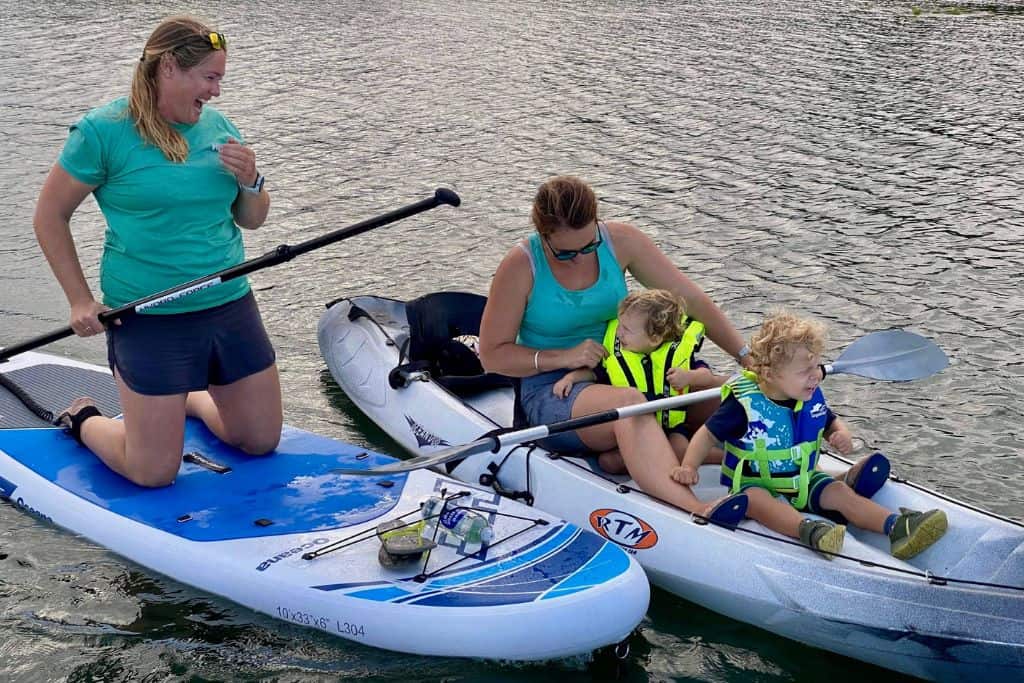
5. Consider taking a kayak class
If you want your kids to learn proper kayaking techniques and tips you could look for a class from an instructor. This is great because in a group environment with kayaking lessons, they’ll learn from the other kids as well as the teacher. Plus they usually play lots of fun games to help them get excited about kayaking.
6. Go with a kayaking group
If you’re new to kayaking then a great way to get started is to join a tour. A majority of kayak tours are great for beginners and families.
7. Try before you buy
Most rivers or coastal regions have places where you can rent kayaks. This is great because you don’t have to set-up or transport your own kayak, it can also be more cost effective if you only paddle a couple of times a year and don’t have space to store a kayak.
8. Involve your kids in the planning process
We always chat away to our boys about our plans, and talk about the next adventure. that we’re about to have an how exciting it is. We often get them playing in the kayak at home, and as we have an inflatable one we always get our eldest to help with pumping it up and setting it up.
9. Never strap a child into a kayak
You should never strap your child into a kayak. You’ll want them to be free of the kayak so that if you do have an accident or capsize that they are able to move away from the kayak.
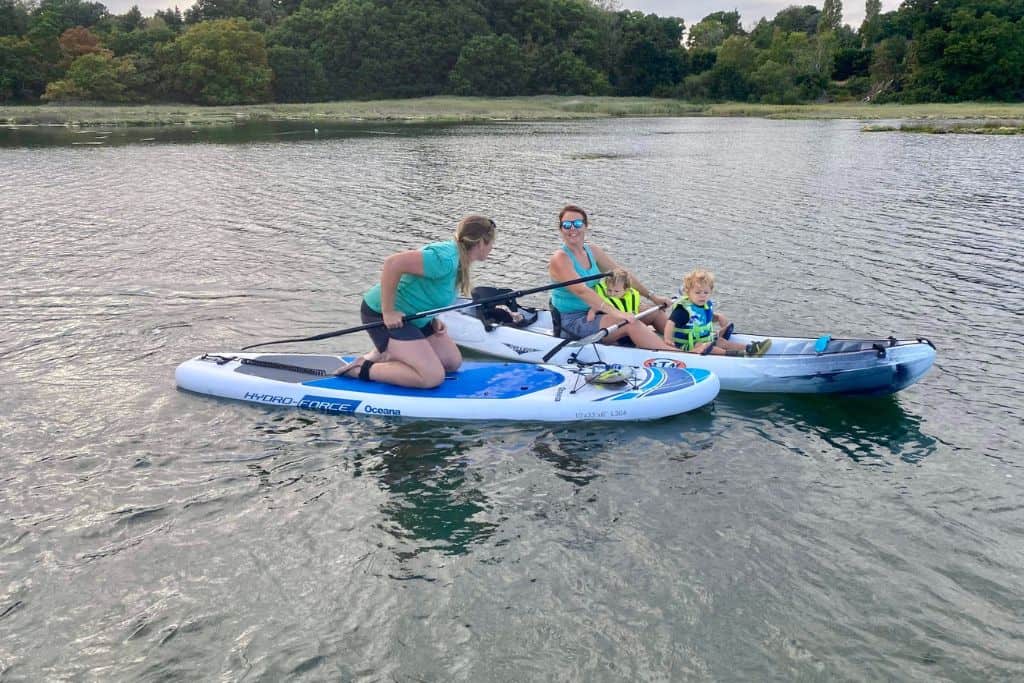
10. Check the weather and tides before you go
Alway check the weather and tides, because otherwise you could find that you run into problems. For instance you could be paddling an estuary and find that at low tide you can’t paddle where you want to get to. Or, you may find that with strong winds and tide in the same direction you could struggle to paddle against them to where you want to go. We always prepare ourselves to bail if the conditions aren’t right.
10 Essentials to Take When Kayaking With Kids
1. Water
You should definitely bring more water than you think you’ll need. If it’s a warm sunny day then you’ll find that you want to keep hydrated, we offer frequent water stops as we paddle. Make sure that your water bottle easy to reach as you kayak along.
2. Bring snacks
Snacks with kids of any age are a saviour! If yours are anything like ours then they’ll be always asking for more snacks. Make sure to bring loads of easy to eat snacks like trail mix or flapjack bars.
3. Navigation Tools
Depending on where you’re going paddling you may want to use a phone for a map and want to pop it into a waterproof case. If you’re going far and there isn’t going to be any signal you may want to take a waterproof map and a compass with you as an emergency backup.
4. Light
Even if you’re planning on paddling during the day and only staying out for a short while it’s helpful to carry a flashlight or headlamp with you “just in case”.
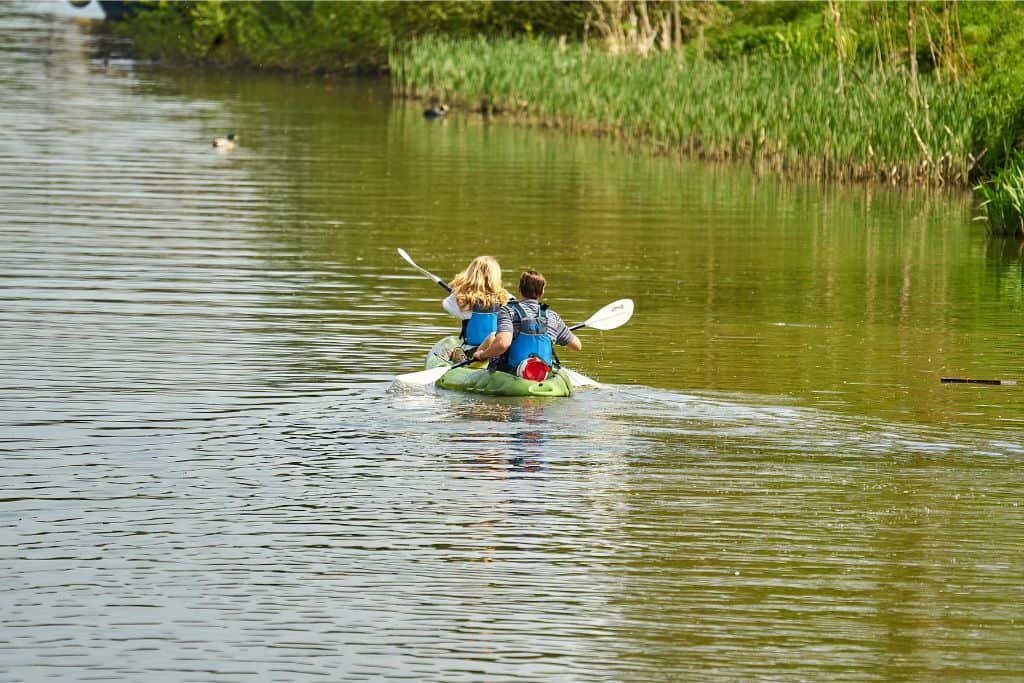
5. First Aid Kit For Kayaking With Kids
As we suggested earlier in our safety section, you should carry a good first aid kit with everything you might need in it. We also carry insect repellent because at dusk (depending on where you are) mosquitos and “no see-um” come out and might try to bite your kids.
6. Extra Clothing
As we have younger children we always have spare clothes with us. For older kids, the clothes will depend in part on the weather, however, you’ll probably want dry clothes for when you finish your on the water adventure Plus you should think about bringing a waterproof or base layer for if there are changes in the weather. As Carl says “there’s no such thing as bad weather, just bad clothing!”.
7. Multitool
Another favourite of Carl’s (quite rightly) is to carry a multitool whenever we go on an adventure. You’ll be surprised how much you’ll use a multitool on your adventures. Whether you need it to help patch your boat or cut open a tricky snack bag.
8. Sun Protection
Good sun protection is very invaluable when kayaking with kids, especially with younger kids who burn more easily. We always wear a baseball cap and sunglasses when we are on the water. If it’s really sunny then we all (adults and kids) wear sun-protective UV clothing. That way we don’t have to remember to reapplying sun cream. As we live in Antigua we spend a lot of time in the sun. This makes us big fans of applying high SPF sun cream on any unprotected skin and especially our faces.
9. Fire Supplies
A bit of a random one to add, however, being able to make a fire can be a big difference in case of an emergency. It’s so easy to carry a lighter in your dry-bag along with some sort of fire starter just in case.

10. Emergency Shelter
Carrying a small emergency shelter, such as a simple and compact foil space blanket, will shelter you in an unexpected storm. And can even double as a good blanket for your young children if the weather becomes cold.
11. Dry Bag
We have a large selection of dry bags (Carl again!). They are a great way to make sure that your gear doesn’t get wet while you’re on the water. Some kayaks come with compartments that should keep your stuff relatively dry, however, it’s better to be safe than wet. Especially in case you capsize or there’s a rain storm when everything will get properly wet. You can stuff everything that you want to keep dry, like phones or extra clothes, in your dry bag before you head out onto the water.
12. Safety Whistle
For safety, everyone in your group should ideally have a whistle nearby them, you might even find that there’s on their life jacket. They are handy for a variety of reasons, such as signalling between yourselves when travelling in multiple kayaks, and can be a great help when you can’t see one of the kayaks in your group.
13. Bring Some Fun Extras for Kids
Our boys love taking along their snorkel gear for when we have swimming breaks and a small fishing line (we’re yet to get a bite let alone a fish!). Bring some “fun extras” with you can help to keep really little kids engaged and interested. You should let them pick what they bring as it’s likely they’ll enjoy them more if they choose them.
What Clothes to Wear When Your Kayaking with Kids
Warm weather clothes for kayaking
Lightweight and breathable clothing is good idea for comfortably paddling around in warmer weather. For kids, a long sleeve UV protecting top and board shorts are a god option. For adults, a UV rated long sleeve top and board shorts or maybe quick-drying trousers will keep you more comfortable as well as protect you from the rays of sun. You should also consider bringing along for each of you a lightweight waterproof coat , as you never know when the temperature might drop or if there is going to be a sudden rain shower.
The shoes you wear will depend on where you’ll be kayaking. Most simple water type shoes will work, however, you might decide to get better ones with tread on them if you’re planning to do some exploring.
Sunglasses are great to protect you and your kids eyes against the suns rays that glare from the water. Also, you can wear a good sun hat to protect your skin from the sun, we always battle to put sun cream on as well with our boys as the reflection from the water can sneak under the peak of a hat!

Cold weather kayaking clothes
You probably won’t want to kayak in the middle of winter, however, you can have fun paddling in cooler weather. As with all outdoor adventures, such as skiing, layering the correct fabrics is a game changer when it comes to keeping warm. Keep away from wearing cotton as it won’t wick sweat away and will stay wet for a longer period of time.
Start with a synthetic, merino or wool base layer and then add an insulating mid-layer (such as a fleece). Then on top of it all wear a waterproof final layer like a rain jacket and trouser combo, or a rain suit so that they stay dry when they’re on the water.
It helps to keep their hands warm with some waterproof mittens or gloves and for their feet some woolly socks, and waterproof boots. If you pop on a wool hat, then you’re good to go! Don’t forget to have some spare clothes at the ready in your dry bag for when you finish your adventure or, maybe in case your kids need to get changed.
How to Pick a Kayak For Kayaking With Kids
Deciding between a sit-in or sit-on kayak
When you’re just beginning then a kayak you sit on is probably the best choice. Sit-on kayaks have more stability, there’s less chance they’ll capsize, plus they’re got holes for built-in drainage that make it harder for them to sink. If you do happen to capsize then your child is unlikely to get trapped or panic because they aren’t restricted like they would be in sit-in kayaks. They’re also way easier to get in and out of, and this is perfect if your child like to enjoy lots swim breaks like our boys do!
Single or double kayak
Your child’s size, age and abilities will all affect whether you go doe a single or double kayak. If you’ve got a smaller child who is joining along for a ride (like our boys currently are), then a single person adult kayak could work. A single is also great for wriggly kids who may want to be nearer to you to begin with.
However, if you’re looking for a kayak that your child can grow into and will help them improve their paddling skills, then we’d highly suggest a double kayak or tandem kayak as some people call them. It’s great as it will give your child to option to either take a ride with you. Or, they can paddle from the front (bow of a kayak) seat and you can control the kayak from the back (stern). This means that you keep a watch on them and can give them coaching on their paddling whilst also letting them have some confidence and control by being sat in the front.
After they’ve got the hang of paddling and got some confidence being on the water, the you may want to think about putting them to their own child sized single kayak. You’ll just want to make sure to keep close by as they practice navigating the water on their own and improve their paddling technique.
Rigid or inflatable kayak
This can be a difficult choice to make and really depends on lots of factors. Hopefully the table below can give you some pointers on which might work best for you and your family.
Choosing a paddle
A standard sized paddle will work for most adults, however, it is probably way too heavy and big for a young child. We’d recommend going for a paddle that’s length is between 182 cm (for kids less than 4 feet) and 210 cm (when your child is nearer to 5 feet). Most youth paddles tend to have have a smaller paddle blade and a much narrower shaft that helps to give small hands an easier grip.
Final Thoughts on Kayaking with Kids
Kayaking with kids is a lot of fun! There is a lot to think about and prepare before you go out for the first time. You’ll want to make sure that you have all of the safety equipment that you need and that you have chosen the right kayak for your trip. We hope that our post had helped you to have fun on the water too!
